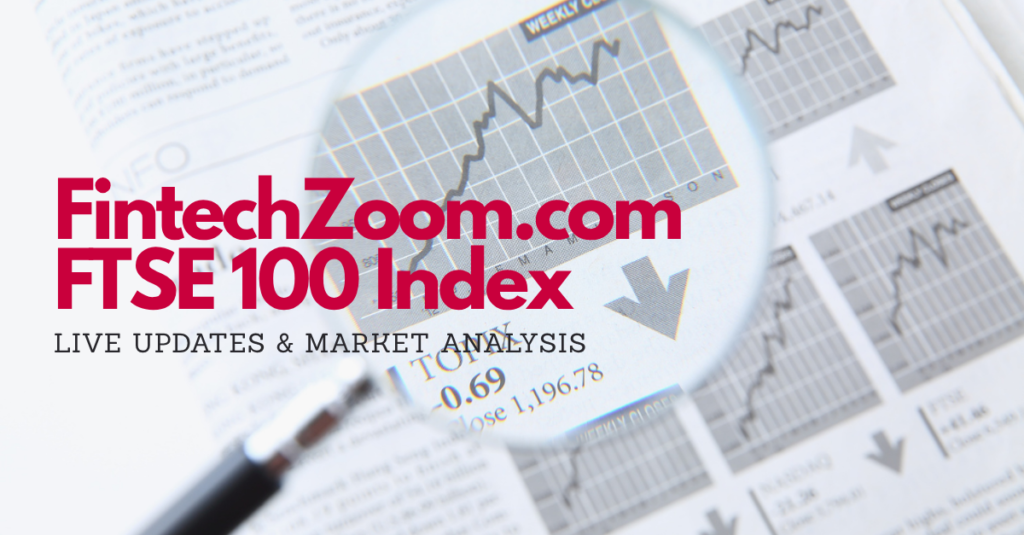The FTSE 100 Index, often referred to as the “Footsie,” is the flagship benchmark of the London Stock Exchange. It represents the 100 largest companies by market capitalization and serves as a barometer for the overall health of the UK economy. When traders, analysts, and policymakers want to gauge investor sentiment, they often look first at the FTSE 100.
- Live Updates: Tracking the FTSE 100 in Real Time
- Key Market Drivers Behind the FTSE 100
- Recent Market Analysis & Performance Trends
- FTSE 100 Live Value and Charts
- FTSE 100 Risers and Fallers Today
- FTSE 100 Dividend Yield and Income Potential
- FTSE 100 vs S&P 500: Global Comparisons
- ETFs Tracking the FTSE 100
- How to Invest in the FTSE 100
- Conclusion
- FAQ's
For global investors, the FTSE 100 is more than just a national index. Many of its constituents are multinational firms like Shell, HSBC, AstraZeneca, and Unilever, whose revenues extend far beyond the UK. This global exposure means the index reflects not only domestic economic conditions but also international trade flows, commodity cycles, and currency dynamics.
This is why resources like fintechzoom.com FTSE 100 have become essential. They provide live updates, market analysis, and investor insights that help traders track every tick of the index. In this blog, we’ll dive into live performance, explore what’s driving the market, highlight recent analysis, review trending investor searches, and outline future risks and opportunities.
Live Updates: Tracking the FTSE 100 in Real Time

Markets move quickly, and investors cannot afford to rely on yesterday’s numbers. The FTSE 100 trades throughout the London session, reflecting real-time changes in stock prices, currency fluctuations, and global sentiment.
As of late September 2025, the FTSE 100 hovers around the 9,220–9,230 level, after recently hitting a 52-week high above 9,350. The day’s trading range has been relatively tight, with intraday moves influenced by both corporate earnings releases and macroeconomic data.
By checking fintechzoom.com FTSE 100, investors can access live charts, daily movers, and market commentary. This real-time information is particularly valuable for day traders, short-term investors, and fund managers who need intraday context before executing trades.
Live updates aren’t just about the number on the screen — they provide insight into market mood. For example:
- A strong rally may signal optimism over interest rate cuts.
- A sharp dip could indicate fears around inflation or poor corporate guidance.
- Flat trading often reflects caution before major economic announcements.
Key Market Drivers Behind the FTSE 100

A combination of domestic and international forces shapes the FTSE 100’s movements. Understanding these drivers is essential for interpreting market action.
Interest Rates & Inflation
UK inflation currently sits around 3.8%, and the Bank of England has maintained relatively high interest rates to curb price pressures. Investors scrutinize every rate decision, as higher borrowing costs can hurt corporate profits and consumer spending.
Meanwhile, the U.S. Federal Reserve recently cut rates by 25 basis points, creating a ripple effect across global equities. Since many FTSE 100 firms earn revenue in dollars, currency fluctuations tied to Fed policy can also affect the index.
Corporate Earnings
Individual companies have a major influence. For example, Next plc reported strong first-half profits but warned of weaker second-half trading, citing consumer headwinds. AstraZeneca delayed a £270 million investment, citing regulatory uncertainties. These announcements ripple through the index, pulling sentiment up or down depending on the sector’s weight.
Economic Growth & Regulation
Analysts frequently warn of “anaemic” growth in the UK, with pressures from high taxation, regulatory complexity, and weaker job creation. These structural issues weigh on domestic demand and can depress valuations of consumer and financial stocks.
Global Market Influences
Because the FTSE 100 includes global giants like BP and Shell, commodity prices and energy markets also play a crucial role. Oil price swings, trade tensions, and geopolitical events all filter into the daily index level.
Together, these forces explain why the FTSE can rise even when the UK economy looks weak — or fall despite strong domestic data.
Recent Market Analysis & Performance Trends
The FTSE 100 has been on a steady upward trajectory through 2025, outperforming mid-cap peers like the FTSE 250. This reflects the international diversification of its constituents: while the UK faces structural economic challenges, global earnings provide a buffer.
- Year-to-date performance: The index has gained nearly 10% since January.
- 52-week range: From around 7,545 to 9,357.
- Sectors leading gains: Energy (Shell, BP), Pharmaceuticals (AstraZeneca, GSK), and Consumer Staples (Unilever).
- Sectors lagging: UK-centric retailers and real estate firms, pressured by slower consumer demand.
Analysts note that dividend yields remain attractive, averaging around 3.5–4%, making the FTSE a favorite among income-seeking investors.
Reports on fintechzoom.com FTSE 100 highlight how this balance of steady dividends plus global earnings exposure keeps the index resilient even amid UK-specific risks.
FTSE 100 Live Value and Charts

One of the most common investor queries is: “What is the FTSE 100 trading at right now?”
Charts not only provide the live index value but also highlight trends, support and resistance levels, and technical signals. Traders use tools like moving averages and RSI (relative strength index) to identify entry and exit points.
On fintechzoom.com, FTSE 100 investors can view interactive charts, historical comparisons, and technical setups that go beyond raw numbers. This allows for deeper insight into whether the index is overbought, oversold, or trending within a healthy range.
FTSE 100 Risers and Fallers Today

Each day, the FTSE 100’s performance is shaped by its rising and falling stocks.
For example:
- A strong earnings report from a heavyweight like HSBC can push the index upward.
- A regulatory setback for AstraZeneca could drag it down.
Tracking daily movers is critical because it tells investors which sectors are driving momentum. Fintechzoom.com FTSE 100 often highlights top gainers and losers, giving readers immediate visibility into the stocks moving markets.
FTSE 100 Dividend Yield and Income Potential

The FTSE 100 is known for its dividend strength, often providing higher yields than the S&P 500 or DAX. Energy firms, banks, and consumer goods companies contribute significantly to this yield.
For long-term investors, dividends can make up a large share of total returns. A stable yield of 4% annually can be attractive, especially in uncertain markets.
Articles on fintechzoom.com FTSE 100 often emphasize the income play angle, explaining which companies have the strongest track records of maintaining or growing dividends.
FTSE 100 vs S&P 500: Global Comparisons

Investors frequently compare the FTSE 100 with the S&P 500, the U.S. benchmark. While the S&P 500 has surged in recent years thanks to tech dominance, the FTSE offers different strengths:
- S&P 500: Heavily weighted toward technology and growth stocks.
- FTSE 100: More concentrated in energy, finance, and consumer staples, providing stability and dividends.
This means the FTSE often performs better in inflationary or high-interest rate environments, while the S&P thrives in periods of strong tech-led growth.
Many investors choose to diversify between the two. Following fintechzoom.com, the FTSE 100 helps global investors align UK performance with their U.S. exposure.
ETFs Tracking the FTSE 100

Not everyone wants to pick individual UK stocks. Many investors prefer to buy FTSE 100 ETFs or mutual funds, which provide exposure to the entire index in one trade.
Popular FTSE 100 ETFs include:
- iShares Core FTSE 100 UCITS ETF
- Vanguard FTSE 100 UCITS ETF
- HSBC FTSE 100 ETF
These ETFs track the index closely, with low fees, making them a practical option for long-term investors. By checking updates on fintechzoom.com FTSE 100, investors can align ETF decisions with the latest market context.
How to Invest in the FTSE 100

Investing in the FTSE can be approached in several ways:
- Direct stock ownership: Buying shares of FTSE 100 companies.
- ETFs and funds: Gaining broad exposure through passive instruments.
- Derivatives and CFDs: For traders seeking leveraged or short-term positions.
Each strategy carries different risks, from dividend stability to currency fluctuations. Using fintechzoom.com FTSE 100 as a research tool helps investors choose the right method.
Outlook & Risks to Watch in 2025
Looking forward, several risks and opportunities will shape the FTSE’s trajectory:
- Bank of England policy: Whether rates remain high or cuts begin in 2026.
- UK inflation trends: A key determinant of consumer and investor confidence.
- Fiscal and regulatory policies: Taxation and regulation could weigh on corporate profits.
- Global markets: Oil prices, U.S. interest rates, and Chinese demand remain critical external factors.
While uncertainties loom, analysts believe the FTSE’s high-dividend nature and global company exposure make it a steady long-term option.
Conclusion
The FTSE 100 Index remains a cornerstone of global investing, balancing stable dividend returns with international diversification. Its performance reflects both UK-specific conditions and global economic trends.
For investors, the challenge is keeping up with daily shifts, corporate news, and macroeconomic drivers. That’s where fintechzoom.com FTSE 100 comes in: providing live updates, daily risers and fallers, dividend insights, and in-depth analysis to guide smarter investment decisions.
Whether you’re a long-term income investor, a short-term trader, or a global asset allocator, monitoring the FTSE 100 through reliable resources will remain essential in navigating the markets of 2025 and beyond.
FAQ’s
Q: What is the FTSE 100 Index?
A: The FTSE 100 Index is a benchmark of the 100 largest companies by market capitalization listed on the London Stock Exchange. It reflects the overall health of the UK stock market.
Q: How can I get live updates for the FTSE 100?
A: You can follow live updates, charts, and market commentary on platforms like fintechzoom.com FTSE 100, which provide real-time data and analysis.
Q: Which sectors have the most impact on the FTSE 100?
A: Energy, finance, pharmaceuticals, and consumer goods sectors often have the largest influence due to the size and weighting of companies like Shell, HSBC, and AstraZeneca.
Q: How does the FTSE 100 compare to the S&P 500?
A: The FTSE 100 is more weighted toward energy and dividend-paying stocks, while the S&P 500 has a higher concentration of technology and growth companies. This makes the FTSE 100 often more stable during high-interest-rate periods.
Q: Can I invest in the FTSE 100 without buying individual stocks?
A: Yes, investors can gain exposure through ETFs or mutual funds that track the FTSE 100, offering a diversified approach with lower management effort.
Q: What factors influence FTSE 100 performance?
A: Performance is influenced by UK interest rates, inflation, corporate earnings, global economic conditions, and currency fluctuations.
Q: Why should I use FintechZoom.com for FTSE 100 analysis?
A: FintechZoom.com FTSE 100 provides real-time updates, detailed market analysis, trending stock insights, and tools that help investors make informed decisions.




